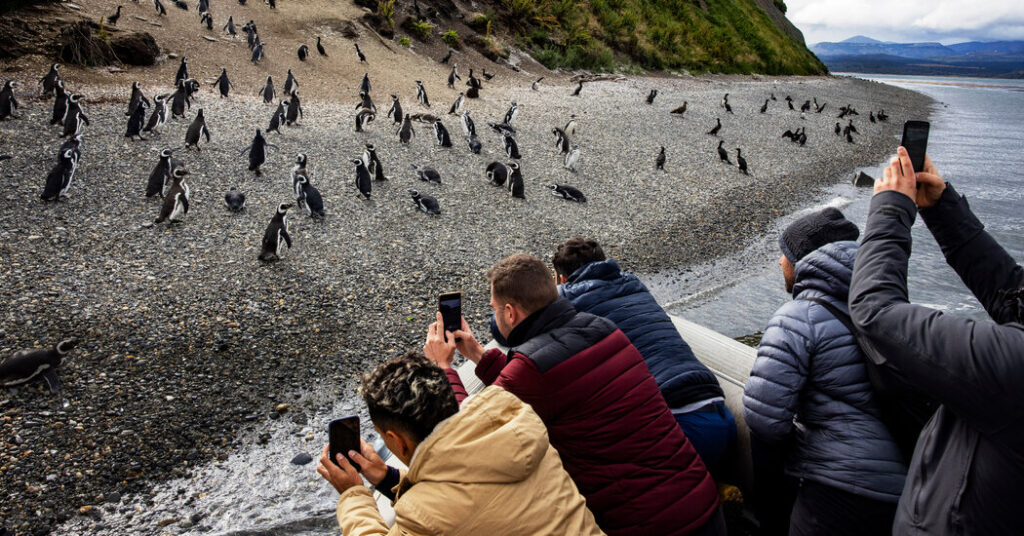It was summer in the city that proudly calls itself the “end of the world,” and the tourists were flocking like the penguins they had traveled thousands of miles to see.
On a late-January afternoon, five hulking cruise ships crowded the docks in Ushuaia, Argentina, waiting to take deep-pocketed passengers who had paid $15,000 to $18,000 each, on average, for once-in-a-lifetime 10-day trips to Antarctica.
A decade ago, about 35,500 Antarctic passengers set out from Ushuaia. Last year, about 111,500 did. This year, as the season draws to an end, the local port authority estimates that the number will be 10 percent higher. Many tourists will spend a night or two in town before or after their cruise, some choosing an Airbnb over a room at one of the city’s mostly humble hotels.
The explosion in tourism is bringing prosperity for the 83,000 residents of Ushuaia, which is squeezed between the Andes and the Beagle Channel. But it’s also taxing resources, raising the cost of living and contributing to a housing shortage for workers. The remoteness, Ushuaia’s biggest selling point, only makes the strain worse.
“We sell an aura,” said Julio Lovece, president of the Ushuaia Foundation XXI, which advocates tourism development that benefits the local community. “Unlike other places that maybe sell waterfalls, or whales, or glaciers, we sell the end of the world.”
Cruising to ‘Another Planet’
Ushuaia, the southernmost city on earth, serves as the main gateway to the Antarctic. Although cruises also leave from Chile, Australia and New Zealand, Ushuaia’s location, only about 600 miles from the tip of Antarctic Peninsula on the island of Tierra del Fuego, explains why it accounts for 90 percent of departures.
The desire to see unspoiled landscapes, unusual animals and vast amounts of ice in an age of global warming draws tourists to the cruises. Gabriel Chocron, a co-founder of the local agency Freestyle Adventure Travel, described visiting Antarctica as “the closest you can get to visiting another planet.”
Ellie Light, 28, a traveler from Dallas, had just returned from an Antarctic cruise and was wandering among downtown Ushuaia’s souvenir shops — where penguin figurines are a hot commodity. She recounted the highlights: a submarine ride to the seafloor to gaze at cold-water reefs and a polar plunge in which a minke whale surfaced next to her just as she was about to jump from a floating platform.
These types of extraordinary experiences are fueling the surge in Antarctic tourism. The cruising season, which previously hewed closely to the austral summer months, December to March, now begins in September and lasts until April. Ushuaia’s port has grown, too. In 2023, more than 32,000 square feet were added to the dock. There are plans to build even more capacity for cruise ships.
Ushuaia has roughly 6,200 beds for tourists on any given night, according to the Tierra del Fuego tourism board, about 40 percent in hotels and at least 30 percent in temporary rentals — most likely an undercount because not all rentals are registered with the tourism authorities. Many of the downtown hotels come with views of the Beagle Channel, but accommodations tend to be rustic and unassuming. Budget lodgings abound, including a new Japanese-style capsule hotel. But tourists hoping for upscale accommodations won’t find much in town: The three five-star options are nature resorts far from the city center.
Aiming to capture a piece of that high-end market, Meliá Hotels announced in late December that it would build a $50 million luxury resort in Ushuaia, featuring a spa, indoor and outdoor pools, and an 800-seat auditorium.
The current lack of high-end options, local tourism officials say, hampers their efforts to persuade cruise passengers to stick around and explore the region.
Clearing Forest to Build Homes
Passengers paying as much as $18,000 for an average Antarctic cruise might be surprised to see how some local workers live. Nolly Ramos León, a 34-year-old single mother of four, has spent years residing on a mountainside where people have cleared the forest to build shacks. The neighborhood offers striking views of the harbor and the luxury cruise ships.
Her first home there was a flimsy structure made of nylon and wood. The family’s new home has better insulation to protect against temperatures that routinely plunge below freezing, but it is still not connected to the power grid or to water and sanitation services. Ms. Ramos León gets some of the family’s water from a nearby stream.
She walks down stairs and dirt paths that become treacherous in winter to reach her job as a housekeeper at a hotel, where she earns roughly $500 a month, plus more for overtime.
According to Ms. Ramos León, the Ushuaia residents who built on the mountain slope did so “to try to live with dignity.” At least 10 percent of Ushuaians live in these types of informal settlements, with scant access to public services. “It took us a long time to get this house built,” Ms. Ramos León said. “Sometimes we didn’t even have money to eat, because I was putting it toward this house.”
Ushuaia’s population has ballooned by 45 percent since 2010, as workers have moved there seeking economic opportunity. But absorbing the newcomers has been difficult. Ringed by mountains, a national park and the water, Ushuaia has had little room to develop housing and infrastructure — and building anything in such remote terrain comes with a hefty price tag.
Most renters in Ushuaia spend roughly 80 percent of their income on housing. A two-bedroom apartment averages 900,000 pesos a month, or about $1,000 at the official exchange rate, according to the local housing advocacy group Que Nos Escuchen. In 2023, rents in Ushuaia outpaced even those of Palermo, one of the trendiest neighborhoods in Buenos Aires.
‘It’s a Dream to See Patagonia’
When the explorer Ferdinand Magellan passed by this island in 1520, he saw Indigenous residents’ fires on shore and named it Tierra del Fuego, Land of Fire. Much of the island, which is today split between Argentina and Chile, remains a wilderness.
Visitors to the island can see penguins and sea lions, hike among the glaciers of Tierra del Fuego National Park, and hit the slopes at Cerro Castor, which stays open longer than any other Argentine ski area.
Tierra del Fuego is one of many major tourist draws in Patagonia, which typically include the colossal Perito Moreno Glacier near El Calafate; Puerto Madryn, a whale-watching haven; and the idyllic mountain town of Bariloche.
“Just like for many Argentines it is a dream to see Paris, I think for many people around the world, nowadays it’s a dream to see Patagonia,” said Mariano Sanchez, a tour guide with Tierra Turismo, a local agency that offers excursions on four-wheel-drive trucks.
Last summer, a record of nearly 640,000 tourists visited Argentina’s portion of Tierra del Fuego, far outnumbering the 190,000 people who live in the province.
The rush has reshaped Silvana Ponce’s business. Her sightseeing agency, Latitud Ushuaia, has grown to 28 employees from six at the beginning of 2020. On the agency’s signature tour, visitors accompany local fishermen to catch and cook the prickly centolla, the southern king crab.
A Remote Wonderland at Risk
As with other resort towns limited by geography and struggling to balance housing and tourism, Ushuaia has few options that are palatable to everyone. Proposals to expand the city limits have bubbled up, but many worry they could do more harm than good. Some within the tourism sector say pumping the brakes on both the city’s and their industry’s growth could be essential to preserving the region’s appeal as a remote, natural wonderland.
“We believe we could continue receiving many more visitors, but we also believe this is the right moment to think about how to not lose control of that growth,” said Mr. Lovece, of the Ushuaia Foundation XXI.
Last year President Javier Milei scrapped Argentina’s rent-control law, one of the world’s strictest. This left many residents in Tierra del Fuego — the province with the highest proportion of renters versus homeowners — struggling even more, according to housing activists. To bring some relief, the local authorities have in recent years imposed a moratorium on the registration of new Airbnb rentals, but they’ve been largely unable to crack down on the spread of unlicensed units.
In a statement, the International Association of Antarctica Tour Operators, which represents the private-sector Antarctic tourism industry, said most cruisers stay in hotels, not private rentals, during their time in Ushuaia, and cited a “commitment to fostering a sustainable balance between tourism and community well-being in Ushuaia.”
Antarctic vacations also have an big impact on the environment: Each traveler accounts for about five tons of carbon dioxide emissions per trip — roughly equivalent to the amount of carbon pollution the average person produces in an entire year; for the average American, it’s closer to 16 tons. Antarctica is warming at a faster pace than the rest of the world, and rising temperatures are already reshaping the landscape around Ushuaia. During a hotter-than-normal summer, a popular ice and rock formation inside Tierra del Fuego National Park collapsed into a slushy heap this year.
According to the I.A.A.T.O., cruises help raise awareness and turn paying customers into ambassadors for the protection of Antarctica. But environmental activists say the time has come to consider hard caps on the number of cruisers, or making at least parts of the continent off-limits to tourism.
Housing activists in Ushuaia also worry about the future as homes become harder to afford. “There’s going to come a moment where it’s going to be all tourists in Ushuaia,” said Maria Elena Caire, president of the Que Nos Escuchen housing group. “And who is going to serve them? Because residents can’t find a place to live.”
Follow New York Times Travel on Instagram and sign up for our Travel Dispatch newsletter to get expert tips on traveling smarter and inspiration for your next vacation. Dreaming up a future getaway or just armchair traveling? Check out our 52 Places to Go in 2025.











More Stories
Attackers Target Prisons in France, Burning Vehicles and Firing Shots
Head of Kuwait Specialty Field Hospital in Gaza Says Israeli Strike Killed a Guard
Assad Defaced: Syrians Destroy a Dictator’s Icons